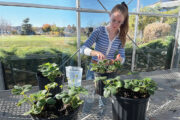
Features
Fertilizer
Innovations in media amendments
Research out of Niagara College aims to minimize fertilizer loss in the greenhouse
October 13, 2023 By Christine George
 Photo of student research assistant, Ashley Paling, monitoring crops grown in media amended with vermicompost and biochar at the Niagara College teaching greenhouse at the Daniel J. Patterson campus in Niagara-on-the-Lake.
PHOTO: Nagara college
Photo of student research assistant, Ashley Paling, monitoring crops grown in media amended with vermicompost and biochar at the Niagara College teaching greenhouse at the Daniel J. Patterson campus in Niagara-on-the-Lake.
PHOTO: Nagara college As the economic climate changes, growers find ways to adapt growing practices to reduce consumption of materials, and ultimately reduce costs. Substrates that growers use to produce healthy, marketable crops is varied – from rock, to peat, to even air. Add on to this the choices of fertility sources and growers’ crop decisions begin long before the seed germinates.
Traditional soilless media, whether it’s based in peat or coco coir, doesn’t naturally hold fertilizer nutrients well. Loss of nutrients through leaching or volatilization (gassing off) is an oftentimes accepted fact when growing a container crop (and in the field!). Any time fertilizer doesn’t make its way into the plant, it comes at a cost – be it out of the farmer’s wallet, or by negatively impacting the environment.
Niagara College’s Horticultural & Environmental Sciences Innovation Centre (HESIC) has recently been working with local businesses to help with this problem. The team has been examining ways, through using various growing media amendments, to minimize fertilizer loss in the greenhouse. Some of their findings show promise not only for the local businesses, but also for the agriculture community.
Biochar
Biochar is one such amendment. Its origin use in agriculture is believed to date back more than 2000 years, in the Amazon basin. Nowadays, biochar is created through controlled burn (pyrolysis) of nutrient-rich, and previously unusable, biomass. The natural ability of biochar to hold nutrients and water appears to be a perfect fit in agriculture, but not all biochar is equal. Biochar can be created from different plant materials such as wood, straw, or food waste, and even animal waste. Depending on the original biomass source, biochar will bring different chemical and physical influences when used as an amendment. Therefore, any new biochar product should be tested before use to understand what benefits, and possible deficits, will result in the growing media. If blended with fertilizers, the result of adding biochar to growing media could be even more valuable.
The HESIC team at Niagara College (NC) Research & Innovation (R&I), in partnership local businesses, has been studying biochar as an amendment to peat moss-based media. To be suitable as a media amendment, the biochar particles must be smaller than one centimetre in length – otherwise the media becomes too porous in container pots. The fertilizer also should be within this size range, which is why vermicompost works well.
Due to its high capacity for holding nutrients, the HESIC studies confirmed that the addition of biochar should be limited to no more than 20 per cent of the total media volume, particularly when biochar has been blended with fertilizer. At higher rates, the biochar can potentially hold too many nutrients, challenging the crop nutrient uptake. While researchers observed that biochar holds positively charged nutrients (cations) such as ammonium, iron and manganese, it may not affect the retention of some negatively charged nutrients (anions) such as nitrate and phosphate. While these observations are important to growers, the key question is: does biochar affect crop growth and quality? The answer is yes – multiple crops, from basil to strawberry – showed signs of higher quality with the presence of biochar in media.
Zeolite
Zeolite is another horticultural amendment being studied at NC R&I due to its capacity to capture and hold nutrients, in a similar way to biochar. However, zeolite is a porous mineral rock that is mined from the earth, in Canada and around the world. There are many other industries harnessing zeolite’s natural properties – air purification, water filtration, animal feed, to name a few. Since 2019, the HESIC team has been studying zeolite in a series of projects funded by the Federal Economic Development Agency for Southern Ontario (FedDev Ontario) and International Zeolite Canada (IZ).
What the team has observed so far is that weight of the media increases when zeolite is blended in – a benefit when a crop such as hydrangea become top-heavy.
The HESIC team has been seeing promising results in their research on fertilizer-infused (or ‘pre-charged’) zeolite in a variety of crops and growing systems. They’ve documented that zeolite pre-charged with a complete nutrient package has the capacity to bring a hydroponics leafy green crop from seed to harvest, with no additional fertility required and in a potentially shorter time than is typically understood. It also has been seen to result in higher plant biomass than in a traditional hydroponics system. In addition, when pre-charged, zeolite is blended with greenhouse media, similar outcomes have been seen by the team. There is a lot more to learn when it comes to agricultural uses of zeolite, and IZ intends to continue supporting research in this area, so growers can understand how best to use this amendment.
Christine George is Research Lead at the Horticultural & Environmental Sciences Innovation Centre at Niagara College. To learn more about these and other research projects at R&I, visit our website at ncinnovation.ca.
Print this page